 |
|
Here and There introduces art, artists, galleries and museums around Japan that non-Japanese readers and first-time visitors may find of particular interest. The writer claims no art expertise, just a subjective viewpoint acquired over many years' residence in Japan.
|
|
 |
|
|
 |
 |
Three Mystics at Musée Hamaguchi Yozo: Yamasa Collection
Alan Gleason |
 |
 |
|
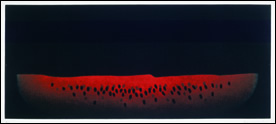 |
| Yozo Hamaguchi, Cloud (1958), mezzotint |
|
Yozo Hamaguchi, Watermelon (1981), color mezzotint |
Just across the street from the Tokyo City Air Terminal in Hakozaki sits an attractively facaded but otherwise unassuming building that currently houses some of the most sublime contemporary art to be found in the city this summer.
Musée Hamaguchi Yozo: Yamasa Collection, which occupies a former warehouse of the 350-year-old Yamasa soy sauce company, is dedicated to the work of mezzotint artist Yozo Hamaguchi (1909-2000). A Yamasa scion (his father was the tenth-generation head of the company), Hamaguchi chose art over the family business, sailing in 1930 for France, where he became enamored of copper-plate engraving. Returning to Japan just before World War II, he made it back to Paris in 1953, and there pioneered in developing color mezzotint techniques. He spent most of his remaining career in Paris and later in San Francisco, not returning to his homeland until 1996. Two years later, and only two years before Hamaguchi's death, Yamasa opened this museum to permanently display his works.
Hamaguchi's mezzotints are the ultimate still lifes: dark, quietistic compositions, either in monochrome or subued colors, of simple motifs, a favorite being fruit -- cherries, lemons, a slice of watermelon. The softness of mezzotint, produced by an arduous, time-consuming process of burring the surface of the copper plate with a rocker, lends a muted, ethereal air to his entire ouevre.
The current show at Musée Hamaguchi Yozo, The Secret Lake, complements a selection of the museum's Hamaguchi holdings with some equally meditative work by three younger Japanese artists, all born in the sixties or seventies. The museum has demonstrated impeccable taste in inviting three artists who employ diverse media to achieve the same exquisite balance of serenity and tension that one finds in Hamaguchi's work. They also share impeccable taste in inviting three artists who employ diverse media to achieve the same exquisite balance of serenity and tension that one finds in Hamaguchi's work. They also share the fierce dedication to craft and technique that Hamaguchi personifies.
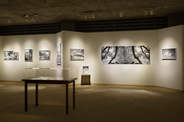 |
|
 |
| Saori Miyake, A secret journey (2013), mixed media (gelatin silver print, C print, chair, frame, showcase, etc.) |
|
Saori Miyake, A no naka no 1 to 2 (2012), gelatin silver print |
Saori Miyake (b. 1975) uses the photogram method of cameraless photography to impart a painterly, impressionistic texture to monochrome images. Her series A secret journey, an installation comprising 11 prints, lines one wall of the upstairs gallery. The largest work, A no naka no 1 to 2 (1 and 2 within A), is a diptych of mirror images of a pastoral scene -- a lake with a small figure in a boat in the distance -- that could be a hazy reconstruction of a childhood memory. Sharing the walls with Miyake are several of Hamaguchi's mezzotints, including his celebrated Watermelon. Despite their disparate methodologies, the two displays sustain an unbroken mood of pensive contemplation of the object.
Downstairs, the larger of two rooms is occupied by the work of Naoyo Fukuda (b. 1967), who uses words, books, and writing tools as her materials. Her utterly original works, which border on the conceptual, are often the product of years of painstaking, repetitive effort. Tsubasa aru mono / kishibe ni te / oritatamareta shomotsu (Objects with wings / on the shore / folded books) is a row of books posed upright on tables, their covers spread from the spine like bird wings, the pages all folded back, one by one, like accordion pleats. Within each book, however, Fukuda has isolated a single line of text for the viewer to read. Stripped of their context, the words are ambiguous -- snippets of a thought, or an encounter between two characters -- but read in sequence they begin to resonate powerfully as a meditation on death and the transience of life. An explanatory sheet lists the titles and authors of the books, which are, interestingly, all translations into Japanese of contemporary Western writers, among them Richard Brautigan, Ray Bradbury, and Douglas Adams.
 |
|
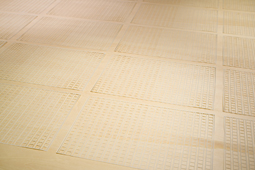 |
Naoyo Fukuda, Tsubasa aru mono /
kishibe ni te / oritatamareta shomotsu (2013) |
|
Naoyo Fukuda, Zanzou / nagi (2010-13), carved manuscript paper |
Fukuda also works with the tools of the writer, converting or subverting manuscript paper, erasers, and bookmark tassels into objects physically deprived of their function. Zanzou / nagi (Afterimage / calm) is a flat display of 35 sheets of Japanese manuscript paper, from which the artist has excised the interior of every one of the 400 square frames on each sheet that provide guides for handwritten characters. A helpful staffer explained that these pages contained compositions Fukuda herself had written as a child. One wonders where all those hiragana and kanji characters went to -- has the artist stashed them away for eventual use in another work?
Finally, one enters a darkened alcove adjacent to the Fukuda exhibit to discover the coup de grace of this show: a single installation by Akiko Ikeuchi (b. 1967) that fills the entire space. Knotted Thread - Red is a web of red silk thread that floats laterally across the room, about a meter off the floor. Stretched from each corner, the threads converge in the center to form a circular hole, from which loose strands dangle toward the floor. It is a simple design, but profoundly mystical; one could spend hours sitting there (fortunately a bench is provided for this purpose) contemplating it from different angles. The work's effect on the imagination is psychedelic. Like the interstellar "trip" sequence at the end of 2001: A Space Odyssey, it sparks an entire spectrum of associations, from black holes to blood vessels. Photographs do not do justice to this piece, which must be experienced in person. Even if it were not joined by the similarly thought-provoking art on display in the other rooms, Ikeuchi's work alone would be worth the trip to Hakozaki.
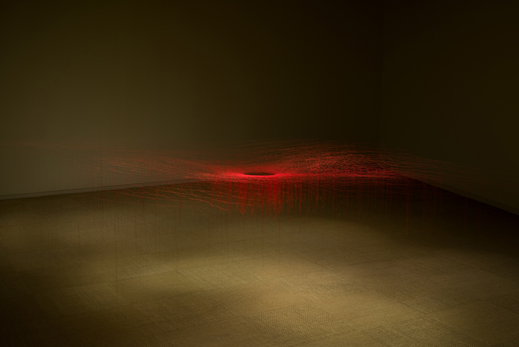 |
| Akiko Ikeuchi, Knotted Thread - Red - h86cm Φ22cm (2011-13), silk thread |
| |
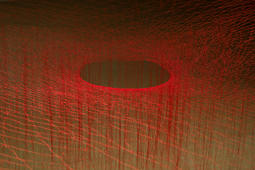 |
|
Detail, Akiko Ikeuchi, Knotted Thread - Red - h86cm Φ22cm (2011-13), silk thread
All images courtesy of Musée Hamaguchi Yozo: Yamasa Collection. |
|
|

 |
The Secret Lake |
 |
Musée Hamaguchi Yozo: Yamasa Collection |
 |
18 May - 11 August 2013
|
| |
1-35-7 Kakigaracho, Nihonbashi, Chuo-ku, Tokyo
Phone: 03-3665-0251
Open 11 a.m. (10 a.m. on Saturdays, Sundays, and national holidays) to 5 p.m.; admission until 4:30 p.m.
Closed Mondays (or Tuesdays when national holidays fall on a Monday), New Year holidays, summer holidays, and maintenance days
Transportation: across the street from Exit 3, Suitengu-mae Station on the Tokyo Metro Hanzomon Line |
|
|
|
|
 |
Alan Gleason
Alan Gleason is a translator, editor and writer based in Tokyo, where he has lived for 28 years. In addition to writing about the Japanese art scene he has edited and translated works on Japanese theater (from kabuki to the avant-garde) and music (both traditional and contemporary). |
|
|
|
 |
|